

GSA EarthCache - An Introduction. How to Have Fun & Learn about the Earth at EarthCache™ Sites Visiting an EarthCache site is a great way to learn more about our wonderful world.
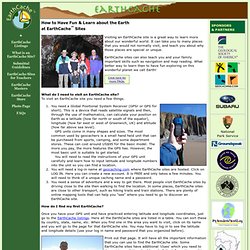
It can take you to many places that you would not normally visit, and teach you about why those places are special or unique. EarthCache sites can also teach you and your family important skills such as navigation and map reading. What better way to learn than to have fun exploring on this wonderful planet we call Earth! Science Education News: HHMI Debuts EarthViewer App for iPad. EarthViewer shows continental arrangements as they shift through time—including Pangea from 215 million years ago.Have you ever wanted to go back in time to see what the Earth looked like 400 million years ago?

You can with the EarthViewer, a free, interactive app designed for the iPad, that lets users explore the Earth’s history with the touch of a finger by scrolling through 4.5 billion years of geological evolution. The app, developed by HHMI’s BioInteractive team, tracks the planet’s continental shifts, compares changes in climate as far back as the planet’s origin, and explores the Earth’s biodiversity over the last 540 million years. It combines visual analysis with hard data, and helps students make connections between geological and biological change.
U.S. National Park ServicePhotos & Multimedia. IcEarth a CNL World Program. USGS Education. Geological Society of America - Educational K-12 Teacher Resources. AMNH.tv. Physical Features of the Ocean. Animations. Each series of animations below contains text, graphics, animations, and videos to help teach Earth Science fundamentals.

Click links or scroll down to view the available animations. Check out our Earth Science Videos pages. Animations Hazards Orphan tsunami How will 3 buildings, engineered equally, on different bedrock react to an earthquake? Plate Tectonics Tectonics & earthquakes of Alaska—More than just plate boundaries NEW! GPS - Understanding Future Earthquakes in the Pacific Northwest Solomon Islands Regional Tectonics Gulf of California tectonics Sumatran Tectonics What is a hotspot? How do Earth's tectonic plates interact?
What is a glacier? Donjek Glacier in the Saint Elias Range, Yukon Territory, Canada. 1985.

—Credit: Natural Resources Canada. Photograph by Douglas Hodgson. Copyright Terrain Sciences Division, Geological Survey of Canada. Water on, in, and above the Earth - USGS Water Science for Schools. The USGS Water Science School A Beta version of the new USGS website has been released for public comment.Use the "Feedback" button at bottom of every Beta page to tell us what you think.

As the saying goes ... "water, water, everywhere. " Well, how much water is there; where is this water; how does it move around? Use the diagram below to find out (select "Menu of all Earth's Water topics" to see a more complete list). Water Cycle Game. Learn about Water Discover Water Project WET. Forces of Nature. Wegener's Puzzling Evidence Exercise (6th Grade) Although Alfred Wegener was not the first to suggest that continents have moved about the Earth, his presentation of carefully compiled evidence for continental drift inspired decades of scientific debate.
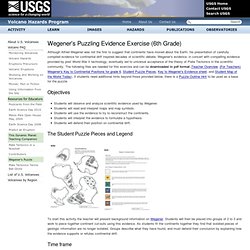
Wegener's evidence, in concert with compelling evidence provided by post World War II technology, eventually led to universal acceptance of the theory of Plate Tectonics in the scientific community. The following files are needed for this exercise and can be downloaded in pdf format (Teacher Overview, (For Teachers) Wegener's Key to Continental Positions for grade 6, Student Puzzle Pieces, Key to Wegener's Evidence sheet, and Student Map of the World Today). If students need additional hints beyond those provided below, there is a Puzzle Outline Hint to be used as a base for the puzzle.
Objectives Students will observe and analyze scientific evidence used by Wegener. Virtual Volcano : Pompeii. How Landslides Work" See more pictures of natural disasters.
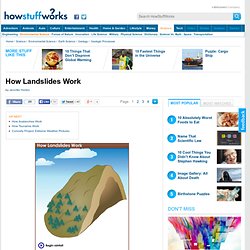
Seismic Waves" This content is not compatible on this device.
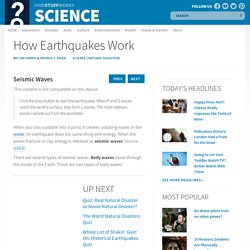
Click the play button to start the earthquake. When P and S waves reach the earth's surface, they form L waves. A Series of Ten Short Articles for Students, Teachers, and Families. Recent images of massive earthquake-induced waves washing away entire towns or buildings reduced to rubble by the violent shaking of Earth’s crustal plates have underlined, all too painfully, the importance of understanding our dynamic and ever-changing Earth.

These natural earthquake hazards will always be with us, but the consequences are not inevitable—if we prepare for them. An essential part of that preparation is education. Education is the key to ensuring that people take appropriate actions when living in earthquakeprone areas and for supporting policies and decisions that will save lives and property. Earthquake Science Explained is a series of short articles for students, teachers, and parents originally published as weekly features in The San Francisco Chronicle. Plate Tectonics: The Scientist Behind the Theory. This Dynamic Earth. View of the planet Earth from the Apollo spacecraft.
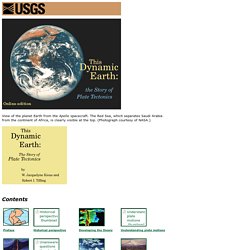
The Red Sea, which separates Saudi Arabia from the continent of Africa, is clearly visible at the top. (Photograph courtesy of NASA.) Plate Tectonics: Further Evidence. Geological Society - The Rock Cycle (KS3) Igneous, Sedimentary, and Metamorphic Rocks. Geologic Time Chart. Geologic Time. 1. The Earth has a long, unique history. Halflife. The applet lists a "halflife" for each radioactive isotope.
What does that mean? The halflife is the amount of time it takes for half of the atoms in a sample to decay. The halflife for a given isotope is always the same ; it doesn't depend on how many atoms you have or on how long they've been sitting around. For example, the applet will tell you that the halflife of beryllium 11 is 13.81 seconds. Let's say you start with, oh, 16 grams of 11Be.